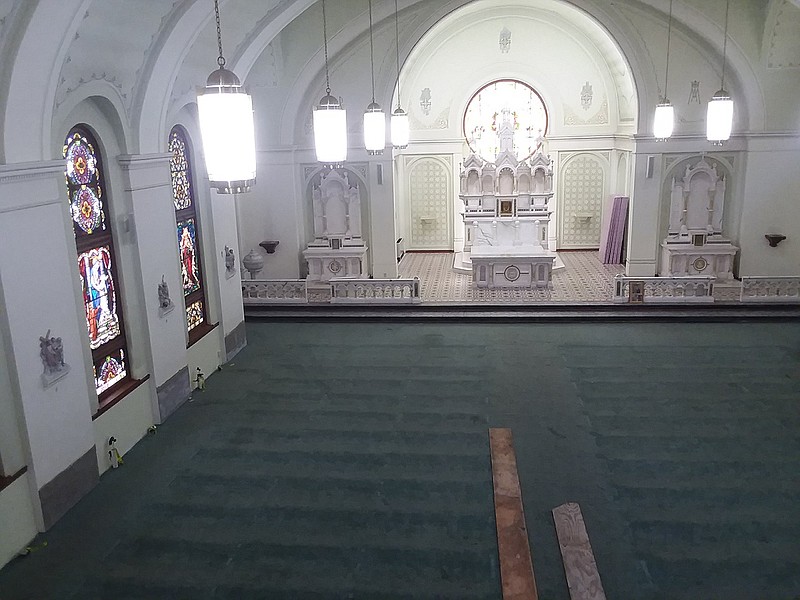It sits silent and empty, patiently awaiting transformation to its original look from nearly 100 years ago.
The sanctuary at St. Edward Catholic Church was stripped of pews and religious relics Thursday as parishioners helped move the items into storage so the final phase of the church's restoration could begin.
Mikey Naples, who is in charge of the church's plant operations and maintenance, was hired by Father Paul Worm eight years ago when he created the buildings and ground commission to restore the church to its original 1923 glory.
He said the transformation began years ago and is now coming to fruition.
"We're on our last journey," he said. "We started eight and a half years ago and we're at our final phase now, and that would be the interior."
Naples said the first phase included sealing the envelope of the church, which included waterproofing the brick sides and the basement and also replacing the roof.
It is now covered with replica tiles of the original 1923 material and are the same color and thickness, he said.
Other upgrades include a new heating and air system.
When the church was last refurbished in 1986, air conditioners were put on the roof and heating was provided by a boiler system, which was estimated to last about 30 years.
"If the whole boiler system went out, we would have had to replace the whole system at an estimated cost of $250,000 to $300,000," he said.
The committee decided to purchase a Mitsubishi mini-split system to provide heat and air to the building and decommission the boiler and air conditioning units.
Vents in the ceiling of the sanctuary will be removed and the holes will be covered with construction foam and repainted, Naples said.
The ceiling's arches were refurbished in the last renovation and contractors put sheetrock on top of them, something Naples said ended up being an unwise decision.
"When I first started working here, there was just this hairline crack," he said. "As the years went on, it grew more and more, up to a three-quarters inch."
Naples said when he finally was able to get up there for a closer look, an eight-foot piece of sheetrock came down when he touched it.
"Back in 1923 when they built it, the beams are about 15 or 16 inches apart," he said. "They didn't have a book when they were doing arches because they're supposed to be 7 or 8 inches apart. When they put the wire mesh in and they put the base coat on, a real heavy base coat about an inch and a quarter, it pulled away from the beams."
Hoover Stucco will refurbish the ceilings and Rod Scott with Yates Company will repaint the stenciling, he said. All the stencils will be brightened and he is working with Sherwin Williams designers in Cleveland, Ohio to determine which colors will be used.
A larger problem the committee encountered in the project is the flooring, which contains asbestos. This week, Snyder Environmental from Little Rock, Ark. will begin the work, which is estimated to take seven to nine days to complete.
To prepare for the abatement, all open surfaces in the church must be covered, including the pipe organ on the balcony and the high altar, or reredos, which holds the tabernacle.
Mass is now being held on the first floor of the church in the parish hall, which has been transformed into a place of worship. A temporary altar is the focal point of the room and many items from above have been relocated there to facilitate worship.
Kelli Nugent, director of faith formation, said they are using stations of the cross Father Worm purchased in the Holy Land. She added that the move went smoothly, as they had a lot of help to do so.
"It has been incredible," she said. "We had a lot of parishioners show up to help us. A tree service company moved the pews."
Work on the project will continue throughout the summer, with additional exterior work being done on the lights in front of the church. The committee had to request permission from the historical commission to cut into the brick to put in new electrical lines, Naples said.
"When the electrician originally did it, they used the ground for the conduit. It all rusted out because it was inside the brick," he said. "When it's done, it's going to be beautiful."
Restorations are expected to be complete by September.

